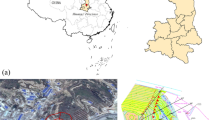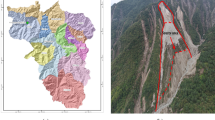Abstract
The construction of expressways in soil and their interaction with railway tunnelling blast excavation faces risks due to limitations on safety vibration velocity regulation on soil landslides. This paper reports on a potential soil landslide coupled with rainfall and blast in an expressway area underneath a railway tunnel in Guangzhou, China. Field monitoring was conducted to obtain the landslide’s geometric features, magnitude, crack distribution, and potential sliding surface. Using the unbalanced force transfer coefficient method, a mechanical model with normal and rainfall conditions was employed to analyse slope stability. Numerical modelling was employed to study the dynamic features of soil slope induced by the blast effect. The triggering factors on topography, tectonics, lithology, rainfall, and blast effects were discussed in detail. A slope mitigation method was proposed, and 6-month surface deformation monitoring was conducted to examine the mitigation effect. The novel results show that the slope was unstable under coupled effect on rainfall and blast conditions, with a potential push-type soil landslide from the top-level slide to the second level. The safety regulation velocity of 3 cm/s for rock slope is too large for safety control on soil slope.























Similar content being viewed by others
References
Bandini A, Berry P, Cormio C, Colaiori M, Lisardi A (2017) Safe excavation of large section tunnels with Earth Pressure Balance Tunnel Boring Machine in gassy rock masses: the Sparvo tunnel case study. Tunn Undergr Space Technol 67:85–97
Cavallaro A, Abate G, Ferraro A, Giannone A, Grasso S (2019) Seismic slope stability analysis of rainfall-induced landslides in Sicily (Italy). In: The 7th international conference on earthquake geotechnical engineering. Rome, Italy, pp 1672–1680
Cavallaro A, Grasso S, Sammito MSV (2022) A seismic microzonation study for some areas around the Mt. Etna Volcano on the East Coast of Sicily, Italy. In: Proceedings of the 4th international conference on performance based design in earthquake geotechnical engineering (Beijing 2022) 52:863–870
Chen Z, Song DQ, Hu C, Ke YT (2020) The September 16, 2017, Linjiabang landslide in Wanyuan County, China: preliminary investigation and emergency mitigation. Landslides 17:191–204
Das S, Sarkar S, Kanungo DP (2022) Rainfall-induced landslide (RFIL) disaster in Dima Hasao, Assam, Northeast India. Landslides 19:2801–2808
Gattinoni P, Consonni M, Francani V, Leonelli G, Lorenzo C (2019) Tunnelling in landslide areas connected to deep seated gravitational deformations: an example in Central Alps (northern Italy). Tunn Undergr Space Technol 93:103100
Guo CQ, Ma G, Xiao HB, Zhou W, Chen HJ, Zhou ZW et al (2022) Displacement back analysis of reservoir landslide based on multi-source monitoring data: a case study of the Cheyiping landslide in the Lancang River Basin, China. Remote Sens 14(11):2683
He KQ, Wang SQ, Du W, Wang SJ (2010) Dynamic features and effects of rainfall on landslides in the Three Gorges Reservoir region, China: using the Xintan landslide and the large Huangya landslide as the examples. Environ Earth Sci 59:1267–1274
He SS, Wang J, Liu SN (2020) Rainfall event-duration thresholds for landslide occurrences in China. Water 12:17
Huang L, Li J, Hao H, Li X (2018) Micro-seismic event detection and location in underground mines by using Convolutional Neural Networks (CNN) and deep learning. Tunn Undergr Space Technol 81:265–276
Huang RQ (2009) Some catastrophic landslides since the twentieth century in the southwest of China. Landslides 6:69–81
Lei H, Wu H, Qian J (2023) Seismic failure mechanism and interaction of the cross tunnel-slope system using Hilbert-Huang transform. Tunn Undergr Space Technol 131:104820
Li DS, Wen Z, Luo J, Zhang ML, Chen B (2019) Slope failure induced by cold snap and continuous precipitation in the seasonal frozen area of Qinghai-Tibet Plateau. Sci Total Environ 694:10
Lin CH, Jan JC, Pu HC, Tu Y, Chen CC, Wu YM (2015) Landslide seismic magnitude. Earth Planet Sci Lett 429:122–127
Long JJ, Li CD, Liu Y, Feng PF, Zuo QJ (2022) A multi-feature fusion transfer learning method for displacement prediction of rainfall reservoir-induced landslide with step-like deformation characteristics. Eng Geol 297:106494
Nafchi RF, Yaghoobi P, Vanani HR, Ostad-Ali-Askari K, Nouri J, Maghsoudlou B (2022) Correction to: Eco-hydrologic stability zonation of dams and power plants using the combined models of SMCE and CEQUALW2. Appl Water Sci 12:55
Rodrigo-Comino J, Seeger M, Iserloh T, Gonzalez JMS, Ruiz-Sinoga JD, Ries JB (2019) Rainfall-simulated quantification of initial soil erosion processes in sloping and poorly maintained terraced vineyards - Key issues for sustainable management systems. Sci Total Environ 660:1047–1057
Sassa K, Wang GH, Fukuoka H, Wang FW, Ochiai T, Sugiyama M et al (2004) Landslide risk evaluation and hazard zoning for rapid and long-travel landslides in urban development areas. Landslides 1:221–235
Shoaei Z (2014) Mechanism of the giant Seimareh Landslide, Iran, and the longevity of its landslide dams. Environ Earth Sci 72:2411–2422
Silhan K, Tichavsky R, Fabianova A, Chalupa V, Chalupova O, Skarpich V et al (2019) Understanding complex slope deformation through tree-ring analyses. Sci Total Environ 665:1083–1094
Talebmorad H, Ostad-Ali-Askari K (2022) Hydro geo-sphere integrated hydrologic model in modeling of wide basins. Sustain Water Resour Manag 8:118
Tanyas H, Gorum T, Fadel I, Yildirim C, Lombardo L (2022) An open dataset for landslides triggered by the 2016 Mw 7.8 Kaikoura earthquake, New Zealand. Landslides 19:1405–1420
Tao T, Shi W, Liang F, Wang X (2022) Failure mechanism and evolution of the Jinhaihu landslide in Bijie City, China, on January 3, 2022. Landslides 19:2727–2736
Wen BP, Wang SJ, Wang EZ, Zhang JM (2004) Characteristics of rapid giant landslides in China. Landslides 1:247–261
Xia M, Ren GM, Yang XL (2021) Mechanism of a catastrophic landslide occurred on May 12, 2019, Qinghai Province, China. Landslides 18:707–720
Yin YP, Wang FW, Sun P (2009) Landslide hazards triggered by the 2008 Wenchuan earthquake, Sichuan, China. Landslides 6:139–152
Zhao XY, Hu HT, Xiong ZY (2014) Landslide-quake: a new mechanism of initiation of large rapid landslides. Engineering Geology for Society and Territory 2:1379–1382
Zhou R, Fang W, Wu J (2020) A risk assessment model of a sewer pipeline in an underground utility tunnel based on a Bayesian network. Tunn Undergr Space Technol 103:103473
Funding
This research was funded by the National Natural Science Foundation of China (No.52204114, No.52274145), the Natural Science Foundation of Jiangsu Province (No. BK20210522), the National Key Research and Development Program of China (No. 2022YFE0128300), and the China Postdoctoral Science Foundation (No. 2023M733758), the Shandong Postdoctoral Science Foundation (No. SDCX-ZG-202302037).
Author information
Authors and Affiliations
Corresponding author
Ethics declarations
Conflict of interest
The authors declare no competing interests.
Rights and permissions
Springer Nature or its licensor (e.g. a society or other partner) holds exclusive rights to this article under a publishing agreement with the author(s) or other rightsholder(s); author self-archiving of the accepted manuscript version of this article is solely governed by the terms of such publishing agreement and applicable law.
About this article
Cite this article
Hao, Y., Liu, C., Zhang, W. et al. Landslide risk evaluation: rainfall and blast-induced potential soil landsides in an expressway area underneath a railway tunnel, Guangzhou, China. Bull Eng Geol Environ 82, 420 (2023). https://doi.org/10.1007/s10064-023-03449-0
Received:
Accepted:
Published:
DOI: https://doi.org/10.1007/s10064-023-03449-0




